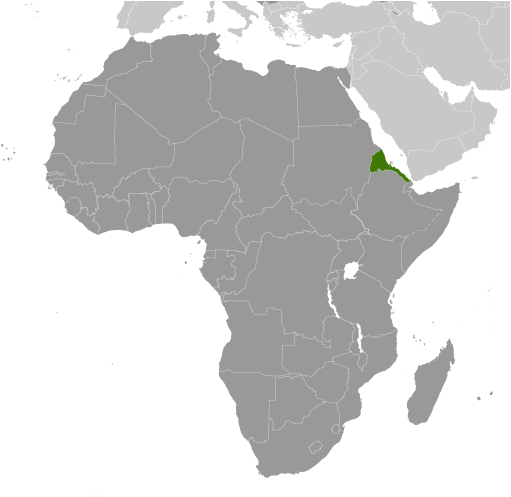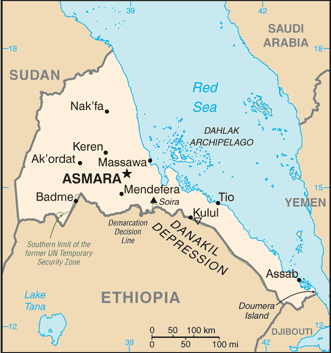|
Country name:
|

|
|
conventional long form: State of Eritrea
conventional short form:
Eritrea
local long form:
Hagere Ertra
local short form:
Ertra
former:
Eritrea Autonomous Region in Ethiopia
|
|
|
Government type:
|

|
|
transitional government
note:
following a successful referendum on independence for the Autonomous Region of Eritrea on 23-25 April 1993, a National Assembly, composed entirely of the People's Front for Democracy and Justice or PFDJ, was established as a transitional legislature and a Constitutional Commission was established to draft a constitution; ISAIAS Afworki was named president by the transitional legislature; the constitution, ratified in May 1997, did not enter into effect, pending parliamentary and presidential elections; parliamentary elections were scheduled in December 2001 but were postponed indefinitely; currently the PFDJ is the sole legal party and controls all national, regional, and local political offices
|
|
|
Capital:
|

|
|
name: Asmara (Asmera)
geographic coordinates:
15 20 N, 38 56 E
time difference:
UTC+3 (8 hours ahead of Washington, DC during Standard Time)
|
|
|
Administrative divisions:
|

|
|
6 regions (zobatat, singular - zoba); Anseba, Debub (South), Debubawi K'eyih Bahri (Southern Red Sea), Gash Barka, Ma'akel (Central), Semenawi Keyih Bahri (Northern Red Sea)
|
|
|
Independence:
|

|
|
24 May 1993 (from Ethiopia)
|
|
|
National holiday:
|

|
|
Independence Day, 24 May (1993)
|
|
|
Constitution:
|

|
|
adopted 23 May 1997, but never fully implemented
|
|
|
Legal system:
|

|
|
mixed legal system of civil, customary, and Islamic religious law
|
|
|
International law organization participation:
|

|
|
has not submitted an ICJ jurisdiction declaration; non-party state to the ICCt
|
|
|
Suffrage:
|

|
|
18 years of age; universal
|
|
|
Executive branch:
|

|
|
chief of state: President ISAIAS Afworki (since 8 June 1993); note - the president is both the chief of state and head of government and is head of the State Council and National Assembly
head of government:
President ISAIAS Afworki (since 8 June 1993)
cabinet:
State Council the collective exercises executive authority; members appointed by the president
(For more information visit the World Leaders website  ) )
elections:
president elected by the National Assembly for a five-year term (eligible for a second term); the most recent and only election was held on 8 June 1993 (next election date uncertain as the National Assembly did not hold a presidential election in December 2001 as anticipated)
election results:
ISAIAS Afworki elected president by the transitional National Assembly; percent of National Assembly vote - ISAIAS Afworki 95%, other 5%
|
|
|
Legislative branch:
|

|
|
unicameral National Assembly (150 seats; members elected by direct popular vote to serve five-year terms)
elections:
in May 1997, following the adoption of the new constitution, 75 members of the PFDJ Central Committee (the old Central Committee of the EPLF), 60 members of the 527-member Constituent Assembly, which had been established in 1997 to discuss and ratify the new constitution, and 15 representatives of Eritreans living abroad were formed into a Transitional National Assembly to serve as the country's legislative body until countrywide elections to a National Assembly were held; although only 75 of 150 members of the Transitional National Assembly were elected, the constitution stipulates that once past the transition stage, all members of the National Assembly will be elected by secret ballot of all eligible voters; National Assembly elections scheduled for December 2001 were postponed indefinitely
|
|
|
Judicial branch:
|

|
|
Supreme Court; Regional, subregional, and village courts
|
|
|
Political parties and leaders:
|

|
|
People's Front for Democracy and Justice or PFDJ [ISAIAS Afworki] (the only party recognized by the government); note - a National Assembly committee drafted a law on political parties in January 2001, but the full National Assembly never debated or voted on it
|
|
|
Political pressure groups and leaders:
|

|
|
Democratic Movement for the Liberation of Eritrean Kunama (DMLEK); Eritrean Democratic Alliance (EDA); Eritrean National Congress for Democratic Change (ENCDC); Eritrean National Salvation Front (ENSF); Eritrean Islamic Party for Justice and Development (EIPJD) (includes the Eritrean Islamic Jihad (EIJ), Eritrean Islamic Jihad Movement (EIJM), Eritrean Islamic Salvation, and the Eritrean Islamic Foundation); Eritrean People's Democratic Party (EPDP); Red Sea Afar Democratic Organization (RSADO)
|
|
|
International organization participation:
|

|
|
ACP, AfDB, AU, COMESA, FAO, G-77, IAEA, IBRD, ICAO, ICC (NGOs), IDA, IFAD, IFC, IFRCS (observer), ILO, IMF, IMO, Interpol, IOC, ISO (subscriber), ITU, ITUC (NGOs), LAS (observer), MIGA, NAM, OPCW, PCA, UN, UNCTAD, UNESCO, UNIDO, UNWTO, UPU, WCO, WFTU (NGOs), WHO, WIPO, WMO
|
|
|
Diplomatic representation in the US:
|

|
|
chief of mission: Ambassador (vacant); Charge d'Affaires BERHANE Gebrehiwet Solomon
chancery:
1708 New Hampshire Avenue NW, Washington, DC 20009
telephone:
[1] (202) 319-1991
FAX:
[1] (202) 319-1304
|
|
|
Diplomatic representation from the US:
|

|
|
chief of mission: Ambassador (vacant); Charge d'Affaires Sue BREMNER
embassy:
179 Ala Street, Asmara
mailing address:
P. O. Box 211, Asmara
telephone:
[291] (1) 120004
FAX:
[291] (1) 127584
|
|
|
Flag description:
|

|
|
red isosceles triangle (based on the hoist side) dividing the flag into two right triangles; the upper triangle is green, the lower one is blue; a gold wreath encircling a gold olive branch is centered on the hoist side of the red triangle; green stands for the country's agriculture economy, red signifies the blood shed in the fight for freedom, and blue symbolizes the bounty of the sea; the wreath-olive branch symbol is similar to that on the first flag of Eritrea from 1952; the shape of the red triangle broadly mimics the shape of the country
|
|
|
National symbol(s):
|

|
|
camel
|
|
|
National anthem:
|

|
|
name: "Ertra, Ertra, Ertra" (Eritrea, Eritrea, Eritrea)
lyrics/music:
SOLOMON Tsehaye Beraki/Isaac Abraham MEHAREZGI and ARON Tekle Tesfatsion
note:
adopted 1993; upon independence from Ethiopia
|
|
|
|
|





 )
)



